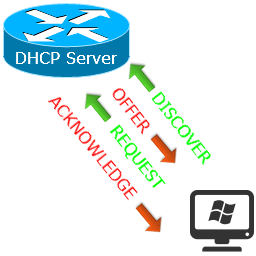A tutorial describing how to configure a Cisco router as a DHCP server, I’ll cover DHCP reservation and excluding of IP addresses as well. A DHCP server dynamically assigns IP addresses to hosts in a network, by creating DHCP reservations we can statically assign an IP address to a host based on its MAC address. IP address exclusion prevents conflicts among devices i certain hosts are manually assigned IP addresses. When configuring DHCP reservation it should be done differently for Windows DHCP clients and Linux DHCP clients because both of them make DHCP requests differently.Continue Reading…
Configure Cisco Console Password
A quick tutorial on how to configure a console password on Cisco routers and switches. A console password is asked for only when connecting to the Cisco device via console port so you will NOT be asked for this password when connecting to your Cisco router/switch via telnet or SSH.
Enter the following commands for configuring a console password
Router>enable Router#configure terminal Router(config)#line console 0 Router(config-line)#password consolepw Router(config-line)#login Router(config-line)#exit Router(config)#service password-encryption
Replace the word consolepw with your preferred password. The service password-encryption command stores the password in encrypted format. Yuo can use these commands for configuring a console password on a Cisco switch too.
Configure Cisco Routers for SSH Access
In the previous article we how to configure Cisco routers and switches for telnet access and in this article we’ll see how to do the same with SSH. SSH is always preferred because it is very much secure than telnet. A quick intro on SSH, it expands to Secure Shell, listens on port 22, uses public key cryptography technique for encryption. Because SSH uses keys we need to generate one on the router. To connect using SSH from a windows system a third party software such as putty us needed, but for Linux users a SSH client is built into all distributions.Continue Reading…
Configure Cisco Routers and Switches for Telnet Access
I wanted to start from the basics as this is the first article under the category Networking. A Tutorial on How to Configure Cisco Routers and Switches for Telnet Access. Lets start with some info about the Telnet protocol – Telnet uses port 23, this protocol is used for remote administration of devices through commands. Take note that Telnet sends commands as plaintext over the network so don’t use telnet this unless you’re on a testing environment or 101% sure your network is safe from intruders.Continue Reading…
CCNA Exam Experience
A couple of months after the RHCE exam I decided to prepare for the CCNA (Cisco Certified Network Associate) exam. I had already attended CCNA classes at an institute here so I just had to prepare for the exam. It wasn’t easy as I thought, I used the CCNA: Cisco Certified Network Associate Study Guide 6th Edition by Todd Lammle, Wiley Publishing book to learn for the CCNA exam. One look at the “Written Lab” section at the end of end of each chapter made me realize my position, I wasn’t even half prepared for the exam. So my journey of exam preparation started.Continue Reading…
PHP Open Port Check Script
A quick tutorial on how to check for open ports using PHP. This function fsockopen() is used in the Open Port Check Tool in this blog. You can check whether a certain port is open on a specified IP address or hostname. Before reading take note that most FREE web hosting providers disable fsockopen() function as a security measure so first check whether the function can be used. Another thing to take note is that if fsockopen is unable to connect to a port it doesn’t necessarily mean that port is closed on the remote host, your server in which the script is running might also have block the OUTBOUND connection to that port.Continue Reading…
- « Previous Page
- 1
- …
- 9
- 10
- 11
- 12
- 13
- …
- 25
- Next Page »



